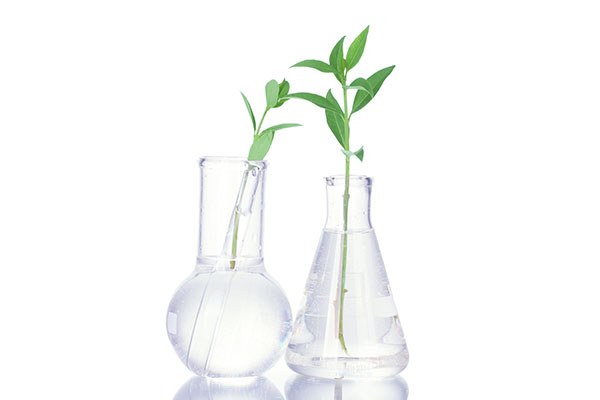Origin: a Latin derivative
meaning "Gift of the Earth."
Part 4: Quality Testing—GCMS

No matter how carefully the distillation process is carried out, essential oils should be tested for their purity and potency before being packaged. Quality testing ensures that every bottle of essential oil contains nothing but 100 percent pure volatile aromatic compounds at the correct ratios to allow for maximum efficacy. Together, gas chromatography, mass spectrometry, infrared spectroscopy, heavy metal testing, organoleptic testing, and microbial testing provide a canon of quality testing procedures that allow for the most thorough analysis possible. Additional tests such as isotopic analysis and chirality testing also provide important information about the quality of essential oils.
There are two main goals of these quality control tests.
- Verify Potency: To identify the chemical composition of the product, which in turn determines the oil’s potency and other properties.
- Ensure Purity: To determine if the oil is pure, or free from contamination and adulteration. An adulteration is the addition of any natural or synthetic component (cheaper essential oil, vegetable oil, mineral oil, essential oil component, etc.) that would cheapen the price of the oil. Not only do adulterations have the potential to alter the chemical and physical properties of the oil, but they can decrease the efficacy of the oil and even cause adverse effects.
Unfortunately, there is no regulatory body that oversees the quality or safety of essential oils. It is therefore up to us to ensure that our products are completely pure, free of adulteration, and have the desired beneficial characteristics.
Video disabled by your privacy settings
Gas Chromatography and Mass Spectrometry Analysis
Invented in the 1940s, gas chromatography has quickly become one of the central tools in analytical chemistry. Gas chromatography makes it possible to know what an essential oil contains by separating the oil into its individual components. The test results present information about which volatile aromatic compounds are present in the oil and at what amounts.
But how exactly does gas chromatography work? The whole process takes place in a complex machine called a gas chromatograph. The essential oil is vaporized in an inert carrier gas (such as helium) and is sent through a tube that is coated in chemical compounds with specific properties. Essential oils are made up of dozens of different aromatic constituents, each of which interacts with the chemical compounds on the walls of the tubes in a different way. As a result, each individual constituent will elute (or move through the tube) at a different speed. A compound will move more quickly if it has little interaction with the compounds coating the tube or more slowly if it has a lot of interaction. A detector at the end of the tube picks up when and how much of a compound exits the tube. Purified compounds can also be sent through the gas chromatograph to help identify each compound. This provides a detailed report of which chemical constituents are present in the essential oil and at what levels.
Mass spectrometry is another method by which essential oils are analyzed for composition. This process requires a special device called a mass spectrometer with three basic parts: a source of ions, a mass detector, and an analyzer. When being evaluated by this method, the essential oil sample (already separated into individual compounds during gas chromatography) is ionized. This means the compound is struck by a stream of electrons that causes the neutral molecule to break apart and become charged. These ions are then sent into a series of magnetic fields, where they will interact based on their molecular mass and charge. On the mass spectrometer reading, each constituent shows up as its own peak based on quantity, the mass, and the charge. Much like a fingerprint, these peaks can be used by an expert to identify the aromatic compounds that make up a given essential oil.
Gas chromatography and mass spectrometry are often used in combination and are commonly referred to as GC/MS analysis.





